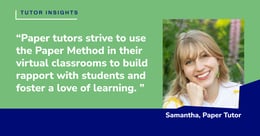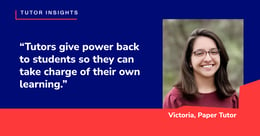
More than just a name: An analysis of the ‘PAPER’ acronym
Part of what makes Paper™ so effective is the Paper Method. Tiffany, one of our dedicated tutors, breaks the whole concept down—one letter at a time.
“That’s not right. No, that’s not right either.”
How often have students heard this from well-intentioned educators who want to correct mistakes, but may overlook the student’s efforts and progress? Of course, it’s important to mend errors and help students improve, but focusing only on what wasn’t done correctly can be discouraging to students. On the other hand, acknowledging what was done well can help create a more positive interaction.
“That’s a good guess! You’re improving a lot!”
The difference here is that these words focus on the student’s strengths, progress, and effort. Such remarks still acknowledge that the student has more to work on, but this need for improvement is framed with a more positive tone.
Uplifting interactions support student learning. That’s because when students associate learning with positivity, they feel more motivated to continue the process.
Due to how imperative this association is, positivity is the first of five components in the Paper Method. Together, these five components form the acronym “PAPER.” And when used together effectively, they can instill a love for learning and a motivation to pursue academics with greater dedication.
P for ‘positive’
The first P in the acronym PAPER, which summarizes the Paper Method, stands for positivity. Here are two examples of comments that communicate the same message, but are structured differently:
- Exhibit A: “Great work so far! I like how clear your arguments are. Do you have citations to support them?”
- Exhibit B: “Where are your citations? Your arguments are clear, but they need citations to support them.”
Both comments address that the student’s essay arguments were clear, but may be lacking in evidence. However, exhibit A starts on a positive note and mentions a strength first and the area for improvement second. When the student reads this comment, they will feel encouraged from the first half and more equipped to respond to the constructive feedback in the second half.
Meanwhile, exhibit B starts more harshly. This may discourage students and could even make them more hesitant to ask for feedback in the future. Even though there’s still positive feedback in this comment, it’s overshadowed by the harsh beginning and the transition word “but,” which diminishes the positive feedback.
To encourage students to keep seeking and receiving constructive feedback, interactions must have a positive tone right from the beginning.
A for ‘adaptable’
As important as positivity is, if an educator is repeating the same thing that isn’t coming across to the student, the student will still feel frustrated. Adaptability involves recognizing what students need and adjusting an approach accordingly.
For example, while helping a student through a challenging physics question, I noticed they had a good grasp of the physics material, but struggled with algebra concepts. Rather than go on with the word problem, I took time to clarify what each variable in the question meant and how we could translate them into an equation.
I also noticed that the method in the solution from the student’s textbook used an approach that could be difficult to grasp—especially given that this student was already struggling with algebra fundamentals. Although I explained the textbook’s solution, I presented a different method that used a more familiar concept. The student found my method easier to understand and remember for future questions.
P for ‘patient’
Even if it’s not the first P in the acronym PAPER, patience is always vital—especially in learning. By the time a student brings a question to a tutor, they’re likely already feeling frustrated that they can’t find the answer or even set up the solution. It’s important for educators to have empathy and to prioritize student-focused learning, which revolves around the student and their learning pace.
One of my most memorable moments while tutoring with Paper was when I helped a student through a difficult multistep calculus question. To simplify the student’s lengthy word problem, I started by prompting them to draw a diagram and write out what variables were given and which variable was needed. For a question about a rate of change, the needed variable would be a derivative—which was also something the student needed to keep in mind while solving this question.
Not long after the student finished their diagram, I was able to complete the question in my notebook. If efficiency was all that mattered, it would be faster to send my solution and let the student read it over. However, that’s ineffective when it comes to genuine learning; it would be like copying a definition from a dictionary and then not knowing how to use the word in a sentence.
Instead, I guided the student through each step using prompting questions, which encouraged the student to predict what the next step should be and think through the solution on their own rather than simply copying someone else’s solution. When we reached the answer, I praised the student—remember the first P!—and asked if they wanted to summarize their process to remember it for future questions.
From the diagram to the student’s summary, the whole question took around three hours! True learning takes time, effort, and sincere dedication, all of which requires patience.
E for ‘engaging’
Sometimes, a Paper tutor may not be able to respond right away, especially when some questions take longer to work through. However, leaving a student hanging is both disrespectful and discouraging to the student.
Chat-based tutoring is unique in that there’s no face-to-face communication, so if a tutor hasn’t sent a message recently, the student may not know that it’s because the tutor is working on the student’s question. So, what can we do to ensure that students always feel supported? Engage them throughout the entire session!
The Paper Method emphasizes an inquiry-based approach to learning. Essentially, this involves using prompting questions that foster thinking and guide the student to find the answer for themself. Here are some examples that make the most out of Paper’s chat-based platform and engage students:
- Asking the student to simplify the question using their own words.
- Ensuring the student understands each term, variable, and so forth.
- Inviting the student to draw a diagram on the whiteboard.
- Asking the student what the next step should look like.
- Prompting the student to explore what the next paragraph or section will cover.
- Reminding the student to find evidence for each argument or claim in an essay.
This way, the student also enhances their own learning—which is far more conducive than simply listening without applying what’s being said.
R for ‘respectful’
The final component of the Paper Method brings us full-circle, as respect encompasses everything discussed so far. Respect for the student and their learning leads to a need to keep the student engaged; respect for the overall learning process leads to a need to be patient with students. Each student has different needs that have to be respected, which leads to a need to be adaptable in one’s approach. Lastly, respect can also manifest as positivity.
As a Paper tutor, I address each student by name, ensure they know that I’m here to help, and praise the student for their efforts. All of this is part of both my and Paper’s core value of respect within the learning environment.
Why the Paper Method works
Together, the five components of the Paper Method and the PAPER acronym—being positive, adaptable, patient, engaging, and respectful—help support an excellent learning environment. When educators demonstrate these traits, students associate learning with positivity, which motivates them to continue learning.

Tiffany, Paper Tutor
Paper supports students and educators in school districts by providing unlimited, 24/7, and multilingual Live Help and Review Center support.
Who are our tutors?



.png?width=260&height=136&name=Blog-Tutor-Insights-Niya%20(1).png)
.png?width=260&height=136&name=Blog-Tutor-Insights-Cynthia-1%20(1).png)
.png?width=260&height=136&name=Blog-Tutor-Insights-Kenna%20(1).png)
